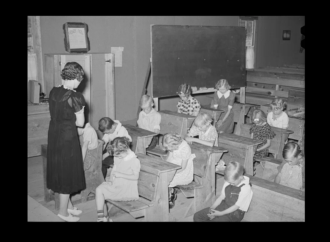If going to an animal shelter, a nursing home, or a daycare makes strong readers and consequently, strong learners, then I’m all for it.
Reading is going to the dogs, particularly in Fort Myers, Florida, Jannis Falkenstern reports in a recent article for the Epoch Times. There, a unique program for beginning readers allows preschoolers and early elementary students to bring books to a local animal shelter and either read to the dogs, or tell the story in their own words if they haven’t yet learned to read.
Researchers at Florida Gulf Coast University have found this program benefits the kids in a number of ways. “They don’t feel judged when reading, and they also get to interact with animals they might not have at home,” said assistant professor of education Melissa Meehan, who came up with this idea. “They also see other children reading and enjoying it. We found that with the participants, they experience an increase in confidence and motivation to read.”
And these sessions with children and books benefit the dogs as well. “Reading to the dogs helps to bring comfort to and reduce the anxiety of shelter dogs, and it nurtures empathy in children,” Meehan says.
But more gifts come from this interaction, chiefly community involvement at an early age. The children leave the shelter feeling they’ve played a part in something bigger than themselves and performed a good deed.
This innovative way of engaging young readers and reducing the stress levels of the dogs caused me to wonder what other venues might serve a parallel purpose.
Suppose you have a six-year-old and an infant at home. Having your first grader read aloud to the baby would not only up the former’s reading levels and abilities, which are very dependent on time spent with books, but would also expose the little one to language, changes in tone of voice, facial expressions, and pictures in the book. Even reading to a favorite stuffed animal, a doll, or Playmobile soldiers can offer our children the freedom to make mistakes without being judged, while giving them more minutes every day with books.
In our schools, we might start a program where a third grader reads for half an hour weekly to a kindergartner. Again, the advantages to both students are obvious. Plus, that five-year-old learns a major goal of education firsthand from that older student.
Someday, when assisted living facilities reopen their doors to the public post COVID-19, the staff of these establishments might consider such read-aloud days for the residents in their care. These literary get-togethers would surely brighten a morning or an afternoon for the aged. They would have the opportunity to enjoy the company of the young, listening to their voices and laughter, and the kids would be exposed to the frailty, gratitude, and wisdom of the old.
Preschool day care centers might do the same, inviting elementary school students to come and open a book with the little ones. Here, too, those students would learn and practice community involvement, improve their reading skills, and bring some sparkle to their listeners.
And for both the elderly and the day care crowd, we might consider having even students in later elementary or middle school, particularly those who are poor readers, bring some books for reading aloud. This would build confidence and literacy in the reader, and would again entertain those listening to them.
“The more that you read, the more things you will know,” Dr. Seuss wrote in I Can Read with My Eyes Shut! “The more that you learn, the more places you’ll go.”
True. And if going to an animal shelter, a nursing home, or a daycare makes strong readers and consequently, strong learners, then I’m all for it.
—
Image Credit: Pxhere
















Leave a Comment
Your email address will not be published. Required fields are marked with *